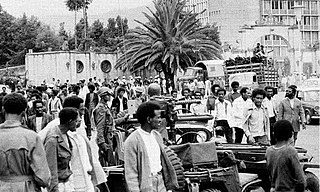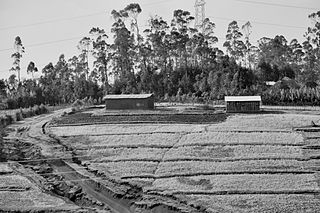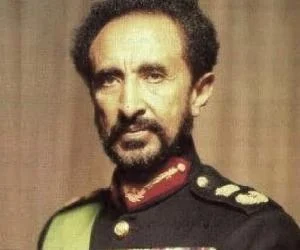Related Research Articles

The politics of Ethiopia are the activities associated with the governance of Ethiopia. The government is structured as a federal parliamentary republic with both a President and Prime Minister. The government is multicameralism with a house of representative and a council. The term politics of Ethiopia mainly relates to the political activities in Ethiopia after the late 20th century when the democratization took place in the nation. The current political structure of Ethiopia was formed after the Tigrayan People's Liberation Front (TPLF) overthrew dictator President Mengistu Haile Mariam in 1991. General election was held in June 1994 and Ethiopia has maintained a multiparty political environment till today.

A widespread famine affected Ethiopia from 1983 to 1985. The worst famine to hit the country in a century, it affected 7.75 million people and left approximately 300,000 to 1.2 million dead. 2.5 million people were internally displaced whereas 400,000 refugees left Ethiopia. Almost 200,000 children were orphaned.

Gojjam is a historical provincial kingdom in northwestern Ethiopia, with its capital city at Debre Marqos.

The People's Democratic Republic of Ethiopia (PDRE) was a socialist state that existed in Ethiopia and present-day Eritrea from 1987 to 1991.
Historically, Ethiopia was divided into provinces, further subdivided into awrajjas or districts, until they were replaced by ethnolinguistic-based regions (kililoch) and chartered cities in 1995.

The Ethiopian Civil War was a civil war in Ethiopia and present-day Eritrea, fought between the Ethiopian military junta known as the Derg and Ethiopian-Eritrean anti-government rebels from 12 September 1974 to 28 May 1991.
Were Ilu is a town in north-central Ethiopia. Located in the Debub Wollo Zone of the Amhara Region, this town has a latitude and longitude of 10°36′N39°26′E. From the 1870s, Were Ilu had a Thursday market.

Agriculture in Ethiopia is the foundation of the country's economy, accounting for half of gross domestic product (GDP), 83.9% of exports, and 80% of total employment.
Major General Hadush "Hayelom" Araya (1955–1996) was an Ethiopian guerrilla commander and former member of the Tigrayan Peoples' Liberation Front (TPLF), which was the leading member of the Ethiopian People's Revolutionary Democratic Front (EPRDF) political coalition. While fighting as a TPLF fighter, he earned the nickname Hayelom, "Overpowering" for his brave and daring acts.

The problem of land reform in Ethiopia has hampered that country's economic development throughout the late 19th and 20th centuries. Attempts to modernize land ownership by giving title either to the peasants who till the soil, or to large-scale farming programs, have been tried under imperial rulers like Emperor Haile Selassie, and under Marxist regimes like the Derg, with mixed results. The present Constitution of Ethiopia, which was put into force January 1995, vests land ownership exclusively "in the State and in the peoples of Ethiopia." The relevant section continues, "Land is a common property of the Nations, Nationalities and Peoples of Ethiopia and shall not be subject to sale or to other means of exchange." Despite these different approaches to land reform, Ethiopia still faces issues of sustainable food self-sufficiency.

Seyoum Mengesha KBE was an army commander and a member of the royal family of the Ethiopian Empire.
Hailu Tekle Haymanot, also named Hailu II of Gojjam, was an army commander and a member of the nobility of the Ethiopian Empire. He represented a provincial ruling elite who were often at odds with the Ethiopian central government. Hailu Tekle Haymanot was an independent-minded potentate who, throughout his life, was mistrustful of and mistrusted by the Emperor.
Villagization was a land reform and resettlement program in Ethiopia implemented by the Derg in 1985 that aimed to systematize and regulate village life and rural agriculture. Villagization typically involved the relocation of rural communities or nomadic groups to planned villages with communal farmland.

Since 1990, the Amhara and Agew people of Ethiopia have been subject to ethnic violence, including massacres by Tigrayan, Oromo and Gumuz ethnic groups among others, which some have characterised as a genocide. Large-scale killings and grave human rights violations followed the implementation of the ethnic-federalist system in the country. In most of the cases, the mass murders were silent with perpetrators from various ethno-militant groups— from TPLF/TDF, OLF–OLA, and Gumuz armed groups.

The fall of the People's Democratic Republic of Ethiopia, also known as Downfall of the People's Democratic Republic of Ethiopia, was a military campaign that resulted the defeat of the ruling party by the rebel coalition Ethiopian People's Revolutionary Democratic Front (EPRDF) on 28 May 1991 in Addis Ababa, ending the Ethiopian Civil War. The Derg took power after deposing Emperor Haile Selassie and the Solomonic dynasty, an imperial dynasty of Ethiopia that began in 1270. The Derg suffered insurgency with different factions, and separatist rebels groups since early their rule, beginning with the Ethiopian Civil War. The 1983–1985 famine, the Red Terror, and resettlement and villagization infamed the Derg with majority of Ethiopians tended to support insurgent groups like the Tigray People's Liberation Front (TPLF) and Eritrean People's Liberation Front (EPLF).
This list details about chronological aspect of the Derg, the military junta that ruled Ethiopia from 1974 to 1987 by decade.

The Ethiopian Civil War (1974–1991) has costed civilian, infrastructure and agricultural impacts. It left at least 1.4 million people dead, with 1 million related to famine and the remainder from violence and conflicts, which is one third of population.

Opposition to Haile Selassie relied largely of internal administration of his country. While Haile Selassie made attempt to modernize the country and brought to global power since Italy's occupation in 1936–41, the later administration met with negative public attitude especially among educated people in universities and peasants.

On 12 September 1974, Emperor Haile Selassie was deposed by the Coordinating Committee of the Armed Forces, Police, and Territorial Army, a Soviet-backed military junta that consequently ruled Ethiopia as the Derg until 28 May 1991.
References
- 1 2 3 4 5 6 7 Mulatu Wubne. "Resettlement and villagization". A Country Study: Ethiopia (Thomas P. Ofcansky and LaVerle Berry, editors). Library of Congress Federal Research Division (1991). This article incorporates text from this source, which is in the public domain. .
- ↑ Richard Pankhurst, "The Ethiopian Famine: Cultural Survival's New Report", Anthropology Today, vol. 2 No. 3 (June 1986), pp. 4-5
- 1 2 Gebru Tereke, The Ethiopian Revolution: War in the Horn of Africa (New Haven: Yale University, 2009), p. 149 n.28
- 1 2 Gebru Tareke, Ethiopian Revolution, p. 149
- 1 2 Gebru Tereke, Ethiopian Revolution, pp. 150
- ↑ "ETHIOPIA: Rural resettlement programme criticised" (IRIN-Africa), March 1, 2004, accessed on July 17, 2011
- ↑ "Resettlement as a Response to Food Insecurity" Archived 2004-09-01 at the Wayback Machine , UN-EUE Report May/June 2003 (accessed 19 February 2009)
- ↑ "Nutrition Survey Report of Chewaka Resettlement Area Bedele Woreda, Illubabur Zone", May 2004, pp. 3f (accessed 27 February 2009)